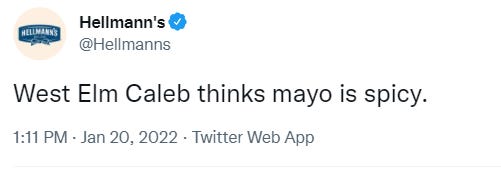I promise that this is only barely about West Elm Caleb. There has been no shortage of great analysis about the situation, its relative inanity, and its greater implications about the new age of social media witch hunts. To catch you up in a sentence: West Elm Caleb is a furniture designer in New York who is bad at dating and because of this his personal and professional lives are ruined for the foreseeable future. To catch you up in a different sentence that will make you beg for death’s release: West Elm Caleb Is TikTok’s Bean Dad
All set? Great!
So it's a new year and the internet has chosen it's first Guy We All Hate. As everyone argued about whether or not the punishment (doxxing and loss of employment) fit the crime (lying/being an inconsiderate dater), The Brands, having sensed that they needed to weigh in, were putting together an unstoppable response to the discourse.
It’s a feeling of discomfort that’s becoming increasingly common online in which the discourse itself, the human beings starting it, and the corporate entities interacting with it, all make you uneasy in different ways. One could understand having a hard time figuring out which direction in which to point our fingers in blame, but they’re all essentially the same direction at this point. This is exactly what the modern social media landscape was designed for and we’re surrounded on all sides by brands. Despite the frequent defense from discourse instigators that they didn’t expect their post to get attention, there is no way to pretend the audience isn’t part of what we’re here for. We’re long overdue to examine the reality of the spaces in which we’re spending our time.
A Semi-Brief Retrospective On The Spaces In Which We Spend Our Time
By my count, social media has had four generations, with each successive generation adopting the most successful aspects of the one before while discovering more efficient ways to hijack human nature.
Facebook Dominance came first, around 2007, when the very idea of interacting with friends online being novel enough to propel onto its eventual metaversal trajectory. It’s easy to forget that the idea of getting into an argument on socials was still considered embarrassing at this point. The old refrain used to be “never read the comments” but then in 2010, the entire internet became the comments. Facebook’s closed networks of friends and family allowed for tension to build between people who’d always disagreed with each other but had thus far managed to remain civil in person. Twitter Dominance was established by opening up those networks and adding incentives. Good posts received likes and retweets, bad posts starting arguments. Everything was for everyone, to go on private was to admit defeat, and Twitter found that an infinite source of attention and outrage was more popular than seeing updates on your stupid friends’ stupid lives.
But Twitter’s popularity gave way to Instagram Dominance around the time of the 2016 US presidential election. Maybe the election’s shocking results made people want to look away from rather than directly into chaos, or maybe they were just sick of reading, but Instagram’s big moment represented the most substantial pivot yet. The goal wasn’t to stoke the fires of outrage, it was to draw attention to the recently founded Influencer class. The term influencer, coined around 2016 (!!), marked the beginning of people understanding how thoroughly viral posts could change your life. Suddenly, people weren’t posting for communication’s sake, they were in a mad dash to find their niche and monetize it. While a viral tweet mostly meant death threats from strangers, reliable virality on Instagram meant lucrative sponsorships, social status, and death threats from strangers. But the world hungered for video. The brief popularity of apps like Vine and Periscope as well as the lasting popularity of forever-scroll functions like Instagram stories, made it clear that people were no longer content looking at staged photos of their new influencers, they needed to see them RAW, REAL, and IN MOTION.
The lesson of all prior generations had left the path to success clear. A social media app could conquer the world by providing a place for strangers to communicate with each other, so long as some of those strangers could eventually use outrage or an aspirational lifestyle to amass a platform big enough to elevate them above the others. At that point, brands could use those newly elevated platforms to sell their products. As long as the algorithm kept shoveling out a personalized array of slop in front of the user base and legal liability for things said on the platform remained nonexistent, there would be millions of people with their eyes glued to whatever you wanted to show them. What nefarious scheme did our corporate overlords have in mind? What would they do with the attention of the world in the palm of their hand? Mostly, they’d try to sell us shoes. As the rule goes, our version of the end of the world must always be the most boring one possible.
And so, TikTok Dominance established itself shortly after. With a bulletproof algorithm and the unparalleled access to our data that we’d all willingly shrugged over to corporations, TikTok perfectly synthesized connection, outrage, aspiration, and self loathing into one unending feed. Everyone became both viewer and viewed. Nobody was a nobody, they’re just a temporarily embarrassed influencer. Seeing perfection, the other networks did everything they could to emulate its model. You too, could have a platform, you too could be the fire everyone gathers around. You just have to post. And so, people post. Arguments start. Winners are declared. Platforms grow, and eventually, somehow, products get sold.
Anyone with a viral post can become a well known personality overnight. Whether positive or negative, those that seek only attention know that the internet will give it to them if they provide the right type of incendiary content. We all understand this, we all know this is how this works, but we still seem to take it at face value when something like this happens and the response from the instigators is simply: “I didn’t expect this to blow up.”
To spell it out as plainly as I can, there is no longer a way to post online without the implied desire to grow and cater to an audience. Every social media platform now functions on the basic idea that having a platform is good and having a large one is better. Sure, you can still attempt to grind out a career for yourself within a niche but appealing to base instincts is where mass appeal is born and mass appeal is what keeps the likes rolling in and the algorithm in your favor. It’s all about finding your audience and making them angry, horny, nostalgic, or if you’re truly skilled, all of the above. Most importantly, the purpose of these platforms has not been focused on facilitating communication between people that actually like each other for over a decade. Pretending as though receiving a dopamine hit that would make a medieval king declare himself a personal friend of Christian God isn’t the desired effect of these websites is disingenuous.
There’s an old adage about cooking frogs in boiling water. It’s said that you can straight up tell a frog that you want to boil it so long as you also tell the frog that it might get famous in the process. The delineation between Brands and human beings online has always been stark, but its purpose on the 2022 social media feed is mostly ornamental. When it comes to questions like “why did brands weigh in on West Elm Caleb?” the answer is simple: we told them to. Discourse is started, signal boosted, and sustained because it generates revenue for two groups, influencers and brands. The passive viewer receives nothing aside from a day’s entertainment, a weird headache when they try to read books, and maybe someday getting doxxed themselves. We log into the Commercial Zone every day, and we tell it what has our attention and then we have the audacity to ask why there are so many commercials in the Commercial Zone. It’s all commercials. We live in and are commercials.
So what do we do? Log off? Unlikely! Between the growing professional necessity of an internet footprint, the isolation of the pandemic, and the non-negligible issue of addiction, most of us are more or less stuck. I can't convince you to log off any more than I convince myself and it’d be patronizing to try. But I think it’s time to get better at spotting the brands and their influence.
It’s embarrassing to have our instincts manipulated. We’ve all felt the overwhelming shame of getting duped by a fake article or post and sheepishly deleting whatever hot take it elicited. But that weathering that shame is so much better for us and the world than refusing to admit that these places are specifically designed for this type of manipulation. As for fixing these spaces and restoring the more social internet that once was, I have no solutions for you. If you truly just want to chat with friends, consider getting back into texting or phone calls. Maybe try discord. But I think at the very least, after all the time we’ve spent here, we should be able to admit where we are. We can’t keep pretending that we don’t expect these outcomes when they happen on such a regular basis. And what I can say with some certainty is that you cannot venture deeper into a space designed for brands expecting to find more humanity within.
Thanks for reading Brain Worms! I took some time off to work on other projects and to travel while it was safe to go outside (and man I’m glad I did given the current circumstances!!)
I’m never going to make anyone pay for unedited stream of consciousness writing about the internet but if you like what I do on here or anywhere else, I have a Patreon that you can check out here. Consider it a digital tip jar for a guy who was dumb enough to establish himself almost exclusively on platforms that pay no money.





